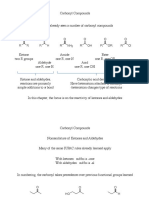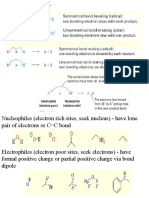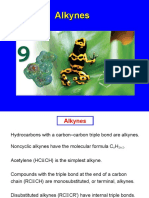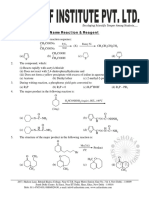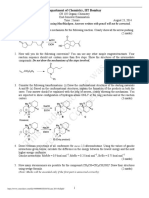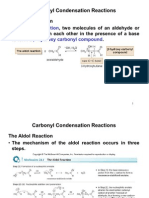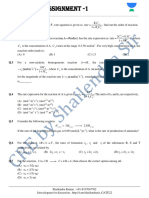Aldehydes and Ketones: Nucleophilic Addition Reactions
Aldehydes and Ketones: Nucleophilic Addition Reactions
Uploaded by
Sandipan SahaCopyright:
Available Formats
Aldehydes and Ketones: Nucleophilic Addition Reactions
Aldehydes and Ketones: Nucleophilic Addition Reactions
Uploaded by
Sandipan SahaOriginal Title
Copyright
Available Formats
Share this document
Did you find this document useful?
Is this content inappropriate?
Copyright:
Available Formats
Aldehydes and Ketones: Nucleophilic Addition Reactions
Aldehydes and Ketones: Nucleophilic Addition Reactions
Uploaded by
Sandipan SahaCopyright:
Available Formats
20 Aldehydes and Ketones:
Nucleophilic Addition
Reactions
Davanone
In the preceding chapter, we saw that the chemistry of the carbonyl group depends upon its polarity.
In this chapter, we will examine the differences in stability and reactivity of aldehydes and ketones.
Many of the reactions we will discuss occur by addition of a nucleophile to the carbonyl carbon and
the addition of an electrophile to the carbonyl oxygen. Sometimes, these reactions produce a stable,
tetrahedral adduct. In other cases, the tetrahedral adduct undergoes further reaction. Nucleophilic
addition to carbonyl groups is a major new class of reaction mechanism.
20.1 Ketones are more stable than aldehydes. If a reactant is stable, a reaction that destroys its structure is
RELATIVE STABILITIES less likely to take place. The carbonyl group of either an aldehyde or a ketone has two resonance forms.
OF ALDEHYDES AND In one form, the carbonyl carbon has a positive charge and the carbonyl oxygen atom has a negative
charge. We know that alkyl groups stabilize carbocations. Thus, the dipolar resonance form of pro-
KETONES panone, in which the carbonyl carbon is bonded to two alkyl groups, is more stable than the dipolar
resonance form of propanal, which is bonded to one alkyl group and a hydrogen atom. The dipolar
resonance form of a ketone is a secondary oxycarbocation; the dipolar resonance form of an aldehyde
is a primary oxycarbocation. The secondary oxycarbocation is more stable. Thus, the carbonyl carbon
of aldehydes is more electrophilic than the carbonyl carbon of ketones.
O O
CH3 C CH3 CH3 C CH3
propanone dipolar resonance structure,
secondary oxycarbocation
O O
CH3 CH2 C H CH3 CH2 C H
propanal dipolar resonance structure,
primary oxycarbocation
The importance of the dipolar resonance forms is reflected in the stabilities of isomeric carbonyl com-
pounds. Propanal is approximately 27 kJ mole-1 less stable than propanone. For addition reactions, two
isomeric products with different stabilities also form. Therefore, we also have to consider the relative
stabilities of the products. Hydrogenation of propanal and propanone gives isomeric alcohols. 1-Propa-
nol is approximately 16 kJ mole-1 less stable than 2-propanol. Because the differences in the stabilities
of the reactants is greater than the difference in the stabilities of the products, the equilibrium constants
for the addition reactions of carbonyl compounds depend more on differences in the structure of the
carbonyl compound than on the differences in the structure of the addition product. Thus, because ke-
tones are more stable than aldehydes, the addition reactions of ketones are less favorable (have smaller
equilibrium constants) than addition reactions of aldehydes.
Organic Chemistry. https://doi.org/10.1016/B978-0-12-812838-1.50020-7 Copyright © 2018 Elsevier Inc. All rights reserved. 595
You might also like
- Exp.5-Reaction of Alkanes, Alkenes, and CycloalkanesNo ratings yetExp.5-Reaction of Alkanes, Alkenes, and Cycloalkanes27 pages
- Gamboa Org 2 Carbonyl Alpha-Subsitution ReactionsNo ratings yetGamboa Org 2 Carbonyl Alpha-Subsitution Reactions47 pages
- ATOOCV1!3!11 Generation Structure Stability and Reactivity of Carbocations Carbanions Free Radicals Carbenes and NitrenesNo ratings yetATOOCV1!3!11 Generation Structure Stability and Reactivity of Carbocations Carbanions Free Radicals Carbenes and Nitrenes32 pages
- Carbonylalphacarbonreactions Lecture2revFMGLNo ratings yetCarbonylalphacarbonreactions Lecture2revFMGL64 pages
- Chapter 22. Carbonyl Alpha-Substitution Reactions: Based On Mcmurry'S Organic Chemistry, 9 EditionNo ratings yetChapter 22. Carbonyl Alpha-Substitution Reactions: Based On Mcmurry'S Organic Chemistry, 9 Edition64 pages
- Chemical Reactivity of Carbonyl CompoundsNo ratings yetChemical Reactivity of Carbonyl Compounds8 pages
- Chapter 19. Aldehydes and Ketones: Nucleophilic Addition ReactionsNo ratings yetChapter 19. Aldehydes and Ketones: Nucleophilic Addition Reactions98 pages
- Alcohols, Phenols and Ethers - Important Notes For NEET Chemistry100% (1)Alcohols, Phenols and Ethers - Important Notes For NEET Chemistry12 pages
- Structural Chemistry Organic Chemistry Summary: Alkynes: Structure, Conformations, PropertiesNo ratings yetStructural Chemistry Organic Chemistry Summary: Alkynes: Structure, Conformations, Properties20 pages
- Aldehydes and Ketones II Aldol Reactions: Enolate AnionsNo ratings yetAldehydes and Ketones II Aldol Reactions: Enolate Anions9 pages
- Hydrocarbons ChapterNotes-JEEMAIN - GURUNo ratings yetHydrocarbons ChapterNotes-JEEMAIN - GURU11 pages
- MSc I CHO 150 Structure Stability and Reaction of Reactive IntermediateNo ratings yetMSc I CHO 150 Structure Stability and Reaction of Reactive Intermediate58 pages
- Wiley's Solomons, Fryhle Snyder Organic Chemistry - 720-742No ratings yetWiley's Solomons, Fryhle Snyder Organic Chemistry - 720-74223 pages
- 12th-Unit 12-Aldehyde, Ketone and Carboxylic AcidNo ratings yet12th-Unit 12-Aldehyde, Ketone and Carboxylic Acid16 pages
- Advances in Organometallic Chemistry and Catalysis: The Silver / Gold Jubilee International Conference on Organometallic Chemistry Celebratory BookFrom EverandAdvances in Organometallic Chemistry and Catalysis: The Silver / Gold Jubilee International Conference on Organometallic Chemistry Celebratory BookArmando J. L. Pombeiro5/5 (1)
- This Study Resource Was: Glance Through The Entire Questions and Solve The Easiest Problems FirstNo ratings yetThis Study Resource Was: Glance Through The Entire Questions and Solve The Easiest Problems First4 pages
- This Study Resource Was: Department of Chemistry, IIT Bombay100% (1)This Study Resource Was: Department of Chemistry, IIT Bombay2 pages
- This Study Resource Was: Department of Chemistry, IIT BombayNo ratings yetThis Study Resource Was: Department of Chemistry, IIT Bombay2 pages
- This Study Resource Was: Chm222A/Se331: Basic Physical Chemistry Homework Assignment - 2No ratings yetThis Study Resource Was: Chm222A/Se331: Basic Physical Chemistry Homework Assignment - 27 pages
- Molecules Levels: Diatomic According TO Wave Mechanics. VibrationalNo ratings yetMolecules Levels: Diatomic According TO Wave Mechanics. Vibrational8 pages
- Solvent-Free Crossed Aldol Condensation of Cyclic Ketones With Aromatic Aldehydes Assisted by Microwave IrradiationNo ratings yetSolvent-Free Crossed Aldol Condensation of Cyclic Ketones With Aromatic Aldehydes Assisted by Microwave Irradiation6 pages
- Chapter 7 C-C C-X Bods Formation With Organometallics 2021 22No ratings yetChapter 7 C-C C-X Bods Formation With Organometallics 2021 2271 pages
- Substitution Reactions On Aromatic Compounds Reinhard BrucknerNo ratings yetSubstitution Reactions On Aromatic Compounds Reinhard Bruckner3 pages
- Grade 10 - SCIENCE: Learning Activity Sheet No.4 Quarter 4 Week 7-8No ratings yetGrade 10 - SCIENCE: Learning Activity Sheet No.4 Quarter 4 Week 7-82 pages
- Chalcone: A Privileged Structure in Medicinal ChemistryNo ratings yetChalcone: A Privileged Structure in Medicinal Chemistry49 pages
- CRE PYQ (1988-2020) : BY Shailendra Sir (SKS50)No ratings yetCRE PYQ (1988-2020) : BY Shailendra Sir (SKS50)60 pages
- Tetrahedron Letters: Payal Malik, Debashis ChakrabortyNo ratings yetTetrahedron Letters: Payal Malik, Debashis Chakraborty3 pages
- Chem 24 Pal Worksheet Bronsted and LewisNo ratings yetChem 24 Pal Worksheet Bronsted and Lewis3 pages
- Class:Ii B.Tech R.V.R.& J.C.College of Engineering (A) CH 302: Chemical Reaction Engineering-I Assignment Test - Ii Branch: Chemical YEAR:2019-20 Time: 60minNo ratings yetClass:Ii B.Tech R.V.R.& J.C.College of Engineering (A) CH 302: Chemical Reaction Engineering-I Assignment Test - Ii Branch: Chemical YEAR:2019-20 Time: 60min1 page
- 4th QUARTER-Module-6-CHEMICAL REACTIONSNo ratings yet4th QUARTER-Module-6-CHEMICAL REACTIONS12 pages
- Electrocyclic Reactions: Dr. Harish ChopraNo ratings yetElectrocyclic Reactions: Dr. Harish Chopra35 pages























